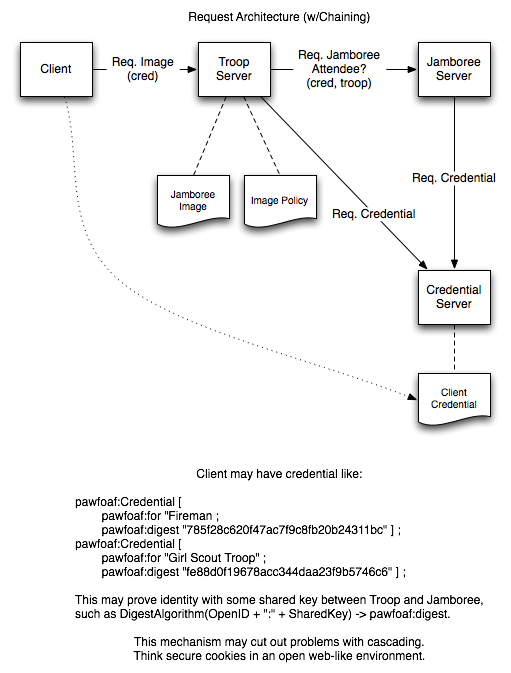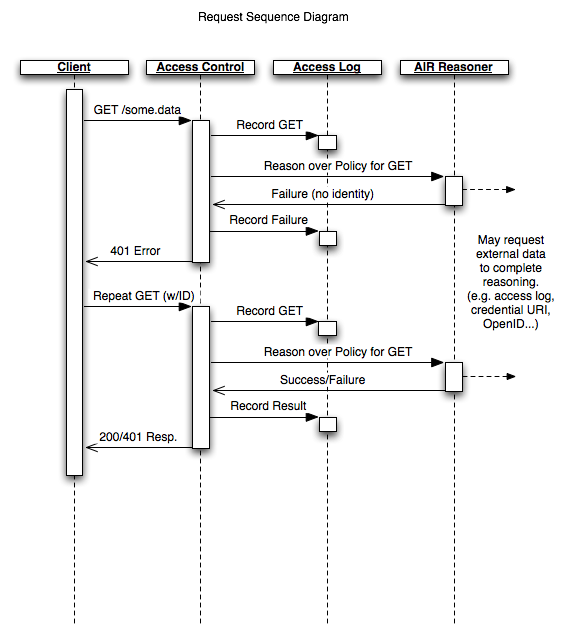- From: Pipian <pipian@pipian.com>
- Date: Wed, 2 Apr 2008 13:54:41 -0400
- To: "Chris Richard" <chris.richard@gmail.com>
- Cc: Story Henry <henry.story@bblfish.net>, Toby A Inkster <tai@g5n.co.uk>, Semantic Web <semantic-web@w3.org>, foaf-dev Friend of a <foaf-dev@lists.foaf-project.org>, HTTP Working Group <ietf-http-wg@w3.org>
- Message-Id: <4AAF2434-EF5B-4FEC-BE16-E20C49167764@pipian.com>
On Apr 2, 2008, at 1:21 PM, Chris Richard wrote: > I really like this. > > Is it too soon to bring up the case of multiple "semantically- > enabled" web servers whereby a server can make a request to a server > on behalf of another user? Suppose a user GETs a web page or a > SPARQL protocol query from a semantically-enabled server. In order > to service that request, the server makes secure requests to several > other semantic servers for protected resources necessary to build > the requested view. The server-to-server requests can use same > authentication process described (steps 2-4 above, note that many > servers already have SSL certificates which is an added bonus). > > However, access to a resource should only be allowed if both the > user and the requesting server are trusted by the owner of the > resource. You can imagine this can be extended to a chain of "on- > behalf-of" requests. Would supporting this be as simple as using a > stack of agent-id values? Servers making a new on-behalf-of request > would simply prepend their id to the list from the incoming request > and servers would be required to confirm that all identities in the > list are trusted or granted appropriate permissions (as you noted > previously, this part is external to the protocol). > > While each server would authorise all parties indicated in the agent- > id list, for a chain of on-behalf-of requests this would require the > server that actually serves a particular protected resource to > authenticate only the requesting party. It would implicitly trust > that each previous server in the chain had taken proper steps to > authenticate their requesting party. > > What do you think? Absolutely. This is more or less the key element of the access control proposal Jim Hendler and I have made in the TAMI project[1]. The project focuses a bit more on the accountability/access aspect, the idea that a server may wish to authenticate against another server (e.g. a server may require proof that you are a fireman to access building blueprints, and in order to do so, your identity is checked against those approved by the local fire department, etc.) I've attached a couple of the architecture images we've been working with that elucidate the 'webby' nature of this authentication scheme (not too dissimilar to those put forth already, though a couple are outdated). I've actually got a mockup of our proposal up already protecting the page http://www.pipian.com/rdf/tami/t42_contacts.html, but it's using our originally proposed OpenID authentication method, which I can elaborate on if you'd like. Ian Jacobi
Attachments
- text/html attachment: stored
- image/png attachment: TAMI_Architecture_Request_Architecture.png

- image/png attachment: TAMI_Architecture_Request_Sequence.png

- image/png attachment: TAMI_Architecture_Server:Client_Architecture.png

Received on Wednesday, 2 April 2008 17:56:02 UTC